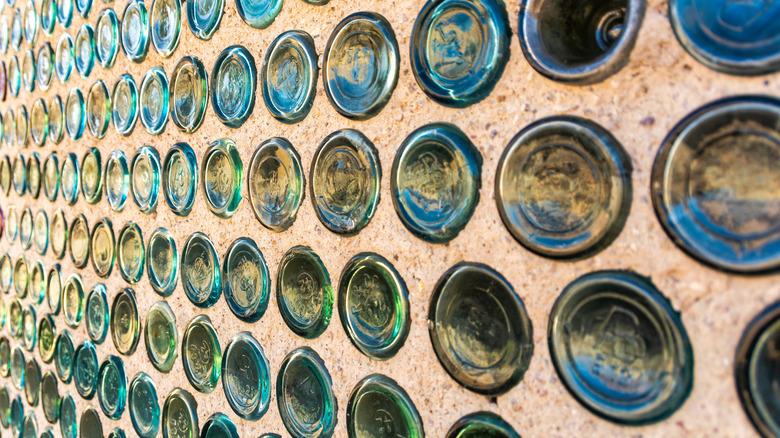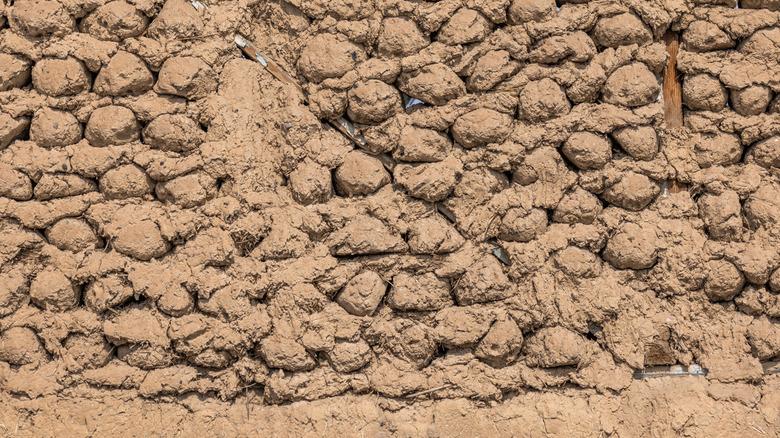How To Reuse Old Glass Bottles And Jars To DIY A Unique Garden Cob Wall
Creating decorative garden walls for your landscape is something many of us think about, but somehow, the details get in the way. What should I build it from? Can I build it myself? Will it cost a fortune? This cob wall idea is just what the doctor ordered. Answering the questions in reverse order: It will be very inexpensive, you can indeed do it yourself, and you should make it from cob and discarded bottles and jars. What is cob? It is a mixture of sand, clay, and straw that is combined to a consistency of modeling clay. You simply plop lumps of it on top of one another, and just like that, you are building a wall. Houses built from cob were common in 18th- and 19th-century Britain. They were durable, warm, weatherproof, and easy to build. They still are, as cob houses are making a bit of a comeback. If building a cob house isn't on your agenda, consider using this technique to build a unique garden wall.
Adding bottles and jars to your wall does a few things for you. First, it adds beautiful detail to the wall. The shapes and colors of the bottles add texture, and if you let them protrude on both sides of your wall, they will catch the light and glow. The bottles and jars will also take up space, meaning that you will need less cob to complete the wall. Lastly, they add an old-fashioned charm to the wall, evoking centuries of tradition. As to the pattern with which you place them in the wall, that is totally up to you.
Wall building as easy as it gets
First off determine where you want your wall to be and its dimensions. Then lay a foundation for the wall from bricks or thick pavers to match your planned dimensions. Next, get busy making your cob. You'll need significant amounts of sand and clay. This can be naturally occurring clay that you dig right out of the ground. The sand can be self-harvested as well or purchased in bags. Lastly, you'll need some bales of straw. Soak some clay in 5-gallon buckets overnight. depression. On a tarp, put a pile of sand and make a depression in its middle. Pour the water out of the clay bucket and plop the clay on the sand in the depression. Take off your shoes and socks and start stomping on the clay and sand, mixing them together. As you do so, mix in a goodly supply of straw. Stomp on the ingredients until they are well mixed, adding water as needed. Congratulations, you've just made cob!
Gather a "loaf" of the mixture about the size of a loaf of bread. Plop it down on top of the wall foundation. Keep plopping loaves of cob next to each other along the length of the foundation. When it's covered, stomp the cob flat the length of the foundation. If you have any of the cob mixture left, start a second layer. If not, make more and build up a second layer of cob on the wall and stomp it down. It's common practice to build up about 12 inches of wall height per day. Allow the cob to dry overnight, and then, with an old carpenter's saw, trim the sides of the cob flush with the foundation, making it as plumb as you can.
Now comes the used bottles
You have now on the way to becoming an experienced cob wall builder. (Certainly, the most experienced in your neighborhood!) With the next layer of cob, you can start adding the bottles and jars. Position them so their bottoms will be exposed when you trim the next layer of cob plumb. If the jars or bottles are too short to bisect the wall completely, lay them end to end. Look at the shapes and colors of the glass objects that you have and imagine a pattern that makes the best use of them. Or you can lay them in uniform layers with each application of the cob. Again, the design is up to you. Just keep mixing up cob and building up about 12-inch layers, and stomping them down.
As you construct the wall, you'll need to allow it to dry. One layer a day will likely be sufficient for you to continue to build. But don't rush things, if the cob is staying very soft, allow additional time for it to dry. If drying is a problem, use less water in your cob mix. You can build cob walls quite tall when they are part of something like a house. Freestanding cob walls have height limitations that depend on the quality of their foundations and the thickness of the wall. A freestanding garden wall like this should top off between 3- and 4 feet tall. You can simply level the top of the cob wall to finish it, but you could also dress it up with natural stones or even pavers.


